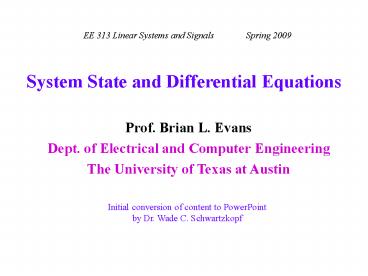Linearity PowerPoint PPT Presentation
1 / 16
Title: Linearity
1
EE 313 Linear Systems and Signals
Spring 2009
System State and Differential Equations
Prof. Brian L. Evans Dept. of Electrical and
Computer Engineering The University of Texas at
Austin
Initial conversion of content to PowerPointby
Dr. Wade C. Schwartzkopf
2
System State
- Example Reformulate Nth-order differential
equation into N simultaneous first-order
differential equations - Define three state variables
- After substituting the state variables, we obtain
a state-space description as
Lathi, 2nd ed, Section 1.10
3
System State
- By putting the state variables in vector x,
- If A is not a function of time, then solution is
- exp(M) for matrix M yields a matrix
4
System State
- General form of state-space description
- State-space descriptions can
- Describe time-varying and nonlinear systems
- Be simulated by computer (e.g. Spice for circuit
simulation) - Knowledge of state variables allows one to
determine every possible output of the system - State-space descriptions covered in controls
courses, e.g. EE 362K Intro. to Automatic Control
5
Continuous-Time Domain Analysis
- Example Differential systems
- There are N derivatives of y(t) and M derivatives
of f(t) - Constants a1, , aN and bN-M, bN-M1, , bN
- Linear constant-coefficient differential equation
- Using short-hand notation,above equation becomes
Lathi, 2nd ed, Section 2.1
6
Continuous-Time Domain Analysis
- Polynomials Q(D) and P(D)
- Normalization aN 1
- N derivatives of y(t)
- M derivatives of f(t)
- This differential system behaves as (M-N)th-order
differentiator if M gt N (see Lathi, p. 151) - Noise occupies both low and high frequencies
- Differentiator amplifies high frequencies (as
well see later in Lathi, Section 4.3-2) - To avoid amplification of noise in high
frequencies, we assume that M ? N
7
Continuous-Time Domain Analysis
- Linearity for any complex constants c1 and c2,
8
Continuous-Time Domain Analysis
- For a system governed by alinear constant
coefficientdifferential equation, - The two components are independent of each other
- Each component can be computed independently of
the other
9
Continuous-Time Domain Analysis
- Zero-input response
- Response when f(t) 0
- Results from internal system conditions only
- Independent of f(t)
- For most filtering applications (e.g. your stereo
system), we want no zero-input response.
- Zero-state response
- Response to non-zero f(t) when system is relaxed
- A system in zero state cannot generate any
response for zero input. - Zero state corresponds to initial conditions
being zero.
10
Zero-Input Response
- Simplest case
- Solution
- For arbitrary constant C
- How is C determined?
- Could C be complex-valued?
11
Zero-Input Response
- General case
- The linear combination of y0(t) and its N
successive derivatives are zero - Assume that y0(t) C e l t
12
Zero-Input Response
- Substituting into the differential equation
- y0(t) C el t is a solution provided that Q(l)
0 - Factor Q(l) to obtain N solutionsAssuming
that no two li terms are equal
13
Zero-Input Response
- Could li be complex?
- If complex, we can write it in Cartesian form
- Exponential solution el t becomes product of two
terms - For conjugate symmetric roots, and conjugate
symmetric constants,
14
Zero-Input Response
- For repeated roots, the solution changes
- Simplest case of a root l repeated twice
- With r repeated roots
15
System Response
- Characteristic equation
- Q(D)y(t) 0
- Polynomial Q(l)
- Characteristic of system
- Independent of the input
- Q(l) roots l1, l2, , lN
- Characteristic roots a.k.a. characteristic
values, eigenvalues, natural frequencies
- Characteristic modes (or natural modes) are the
time-domain responses corresponding to the
characteristic roots - Determine zero-input response
- Influence zero-state response
16
RLC Circuit Similar to Lathi, Ex. 2.2
- Component values
- L 1 H, R 4 W, C 1/40 F
- Realistic breadboard components?
- Loop equations Ex. 1.10
- (D2 4 D 40) y0(t) 0
- Characteristic polynomial
- l2 4 l 40 (l 2 - j 6)(l 2 j 6)
- Initial conditions
- y(0) 2 A
- ý(0) 16.78 A/s
y0(t) 4 e-2t cos(6t - p/3) A

